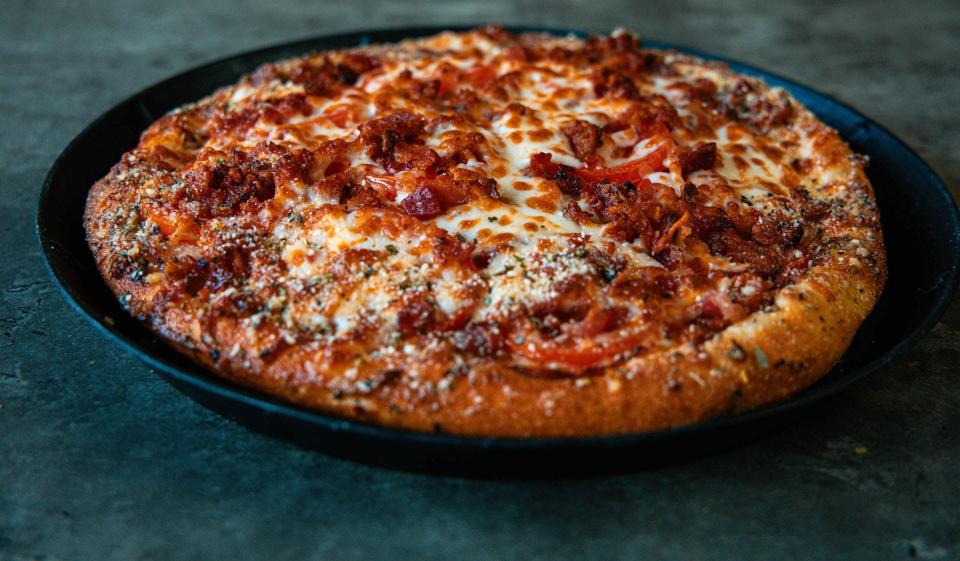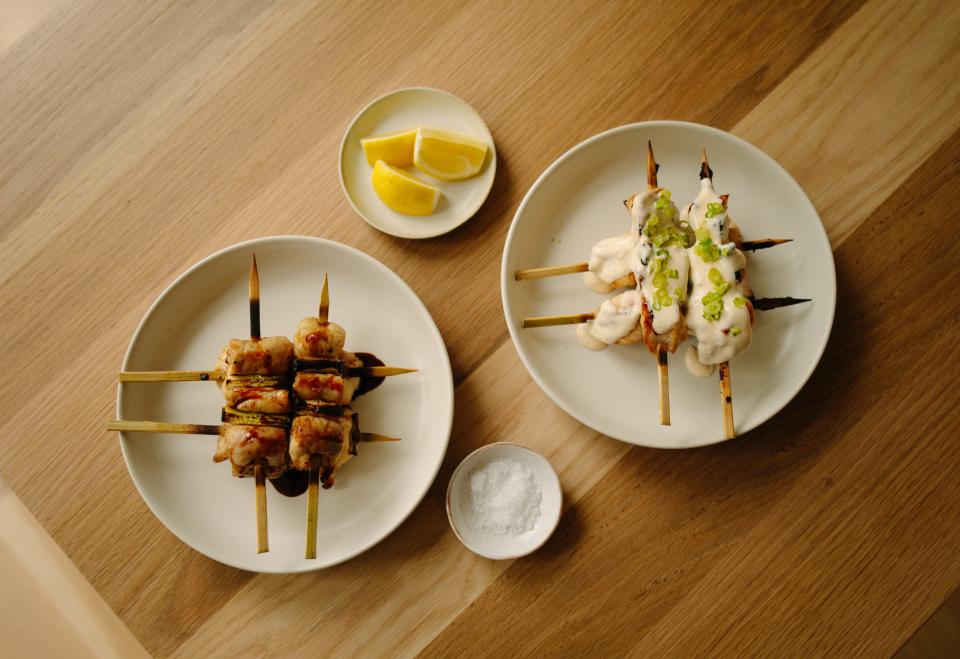Louisville has 1,800 restaurants. How this growing food scene is getting 'better and better'
Whether they live in Louisville or not, people love to say things about the Louisville restaurant scene. Talk has been traveling far and wide about this not-so-little foodie town in Kentucky.
But talk to those who have, for years, worked in this restaurant scene, and worked to build momentum, and the conversation may start with an anecdote like this.
A man originally from Yucatan decided he’d do anything he could to own his own business. He began with a food truck in 1997, when food trucks were not yet a trend, and parked it in an area of Louisville with no foot traffic, yet customers showed up anyway. Thanks to a blend of his drive and his unique recipes, Bruce Ucan’s truck turned into the beloved Mayan Cafe in NuLu.
Ucan calls it a case of right place, right time.

“Louisville was ready to embrace new concepts,” he told The Courier Journal. “People were starving for something new.”
Just like this tale of an underdog finding success here, Louisville could be categorized as an underdog in the race of top food cities as it has continued to earn recognition from online lists, travel magazines, esteemed culinary groups such as the James Beard Foundation, and publications as prestigious as the New York Times.
“People underestimate Louisville,” said chef Dallas McGarity of The Fat Lamb, who recently was named a semifinalist for the highly-acclaimed 2024 James Beard Awards. “They don’t realize the food scene is as good as it is until they come here for something else. Then, it shocks you.”
But what is Louisville's defining quality as a foodie city? Is it steakhouses or fried chicken or tacos? Is it known only for bourbon and Hot Browns? Or is it defined by all of these tastes?
Ucan, McGarity, and other industry insiders the Courier Journal spoke to for this story each have different ways of describing their field:
“We’re right up there with any other food city,” said Chris Williams, who runs Four Pegs Smokehouse & Bar.
“We’ve got one of the best food scenes in the country,” Ernesto Rivera, co-owner of I Love Tacos, said.
“As an independent restaurant scene, I think Louisville is one of the best in the country,” McGarity said.
“I think people are surprised when they come here,” said Stacy Roof, president and CEO of the Kentucky Restaurant Association. “It’s not a bunch of hillbillies and it’s not just fried chicken.”

Talking about it is one thing, but how do you dig into this city’s growing — and ever-changing — culinary mecca? In search of a way to take stock of Louisville’s current restaurant landscape, The Courier Journal analyzed restaurant inspection data from Louisville Metro Government pulled from May 2024.
It shows Louisville, which boasts a population of about 770,000 people, according to U.S. Census Data from 2023, is home to about 1,800 eateries, which include a wide range of cuisines, low and high price points and ambiances for casual or fine-dining.
That’s compared to about 2,300 restaurants in Hamilton County, where Cincinnati, Ohio, is located, according to data from the Bureau of Labor Statistics.
Of the 8,600 restaurants in the state of Kentucky, Lexington has about 600 eating and dining locations, according to Commerce Lexington.

“That is what is so beautiful about Louisville,” said Anne Shadle, co-owner of Mayan Cafe. “The city appreciates we have this food scene enough to try to support it.”
Looking at Louisville’s almost 1,800 restaurants, there’s plenty to bite into. Here's what we learned from our deep dive into Louisville's culinary scene.
What are the most popular cuisines in Louisville?

Using the data pulled from restaurant inspections, The Courier Journal categorized each restaurant with different cuisine types and found that restaurants here represent nearly 60 types of cuisines, from African and Scottish to Creole and Vietnamese.
The top five cuisines found across the city of Louisville include the following:
American: 279 restaurants
Mexican: 223 restaurants
Pizza: 155 restaurants
Chinese: 110 restaurants
Southern: 79 restaurants

There are also more than 70 ice cream shops and 80 coffee or tea houses.
Louisville has roughly 150 bars that serve a limited food menu, more than 30 dedicated breakfast places, more than 30 burger joints (most of which are not national fast-food chain locations), about 40 barbecue spots, and 57 steakhouses.
Where are the most restaurants located in Louisville?
Of the 31 zip codes represented in Louisville, which ones have the most restaurants?
Here are the top zip codes where restaurants are located:
40202 (Downtown Louisville, NuLu): 134 restaurants
40207 (St. Matthews, Indian Hills): 115 restaurants
40206 (Butchertown, Crescent Hill): 110 restaurants
40204 (Highlands, Germantown): 105 restaurants
40222 (Hurstbourne, Lyndon): 96 restaurants
Here are the zip codes with the fewest restaurants:
40118 (Fairdale, South Park): 6 restaurants
40209 (Standiford): 6 restaurants
40242 (Briarwood, Rolling Hills): 7 restaurants
40210 (California, Park Hill): 9 restaurants
40212 (Portland, Shawnee): 17 restaurants
A place to get 'out of your comfort zone'

Under the “American” category, which consists of restaurants that serve upscale, inventive, or classic American fare, including dishes like shrimp-and-grits, beef short rib, and roasted chicken, The Fat Lamb has become a popular spot for locals and tourists since McGarity opened the Highlands spot in 2016.
Originally from South Carolina, the chef is a champion of Louisville’s “melting pot” of cuisines.
“Everyone thinks of Louisville as Southern food,” he said. “I don’t think of it as Southern at all.”
He said longtime restaurants such as Vietnam Kitchen in the Iroquois neighborhood and Queen of Sheba near Bowman Field have “influenced” the rise of other types of restaurants here.
“I think it’s very diverse,” Roof, of the Kentucky Restaurant Association, said. “We have a really good mix of ethnicities and choices. We’ve got a really good makeup for a lot of various cuisines.”
According to the data, Louisville is home to 16 Asian restaurants, three Ethiopian spots, 22 Indian spots, 39 Mediterranean spots, five Peruvian spots, and two Haitian restaurants.
For Rivera, who owns I Love Tacos, which has multiple locations, it was no surprise that the second-most popular cuisine type in the city is Mexican.
After moving here from Texas, he opened his first restaurant in Louisville, called Ernesto’s, in 1998.
About 20 years later, right before the beginning of the COVID-19 pandemic, Rivera felt it was time to switch things up.
He converted Ernesto’s, which served more traditional Mexican plates, into I Love Tacos. He opened the Jeffersontown spot in March 2020, and even with that timing, the fun, taco-focused concept surged. Four locations followed over the next four years.
Rivera said the brand’s success comes in part from considering social media’s impact on the dining experience.
“It’s a new era,” he said. “The food has to look pretty and it has to be tasty.”
His recipes are in part inspired by the home cooking of his mother, a native of Mexico City.
As a longtime member of the local restaurant community, Rivera has some advice for Louisville area residents.
“There are a lot of good restaurants out there,” he said. “Get out of your comfort zone and try something new."
How many chains are there in Louisville vs. local restaurants?
While you may keep seeing big chains pop up in Louisville, local restaurants actually outnumber locations of fast-food chains like Taco Bell, Wendy’s, and others.
According to the restaurant inspection data, Louisville has about 1,077 local restaurant locations and 724 chain locations.
In addition, there are more than 30 Louisville-based chains that only have locations here, including Annie’s Pizza, Con Huevos, Simply Thai, and Taco Luchador.
Louisville is the home base for national chains such as Yum! Brands, which operates locations of KFC, Taco Bell, and Pizza Hut, among others. National brands like Long John Silver's, Papa Johns, Texas Roadhouse, also have corporate offices in the city.
How is Louisville's food scene changing?

In the eyes of Shadle, co-owner of The Mayan Cafe and an operations consultant, there are dozens of stories like Ucan’s in Louisville.
Due to a mix of growing tourism, with a helping hand from the bourbon industry and the draw of massive events like the Kentucky Derby, and a lower cost-of-living compared to other markets, Shadle says Louisville offers “more opportunity for small independent restaurants to get a start.”
“It breeds a space where people can try new things,” she said. “I think that is what sets the stage for us to have a very interesting, thriving restaurant community.”
However, running a restaurant — and keeping it open — is hard work. Some of them survive. Some don’t.
In 2023, at least 40 restaurants closed in the Louisville area and more than 20 spots have closed so far in 2024, according to previous Courier Journal reporting.

In June, the city's sole Australian restaurant announced it would close after nearly five years in business. Harvey's started as a cheese shop in Logan Street Market and expanded into a bar and cafe on Frankfort Avenue.
"It’s really a bummer that it’s so hard to sustain a small restaurant when you don’t have deep pockets, but it seems to be our sad truth," Harvey's stated in a Facebook post. "Despite all that, we’re happy we gave it a go! And I think we can still consider our endeavor a success."
And as labor costs rise and restaurants face other challenges, Shadle says support from the local community is needed to keep local places open.
“The fact that a really authentic Mayan cafe works in Louisville, Kentucky, and has for so long, is truly amazing,” Shadle said.

Chef Lawrence Weeks of North of Bourbon, which serves Louisiana-inspired fare and a huge collection of bourbon, and Enso, which offers a mix of Japanese and Southern food, agrees that plenty of creativity lives in Louisville. Weeks, who also was named a James Beard Award semifinalist in 2024 in the Emerging Chef category, would like to see more support from investors and developers to help small, diverse restaurants flourish.
“I think we need to put our money where our mouth is when we talk about being a restaurant city,” Weeks said.
He, like others, agrees there is room to grow.
Roof, with the Kentucky Restaurant Association, is optimistic that Louisville’s food scene will continue that trajectory.
“Part of our charm is who we are,” she said. “We have charm and hospitality and diversity.”
McGarity also sees a bright future.
“This matters because food drives the community,” he said. “It’s going to get better and better.”
Reach food reporter Amanda Hancock at [email protected].
This article originally appeared on Louisville Courier Journal: Louisville has 1,800 restaurants. What are the most popular types?